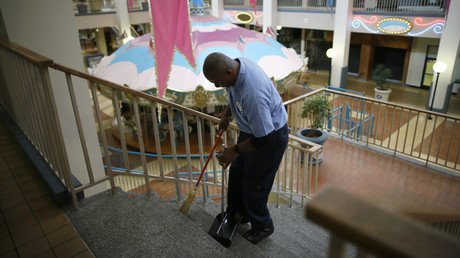Trump train or ‘Thanks, Obama’? Both parties claim credit for January job gains

The US economy showed a dramatic upturn in January with 227,000 new jobs and a surge in full-time employment. President Donald Trump praised the figures, but his critics reckon it's Barack Obama who deserves the credit.
Released on Friday by the Bureau of Labor Statistics (BLS), the January ‘Employment Situation Summary’ said the growth far outpaced the expected 175,000 jobs. The unemployment rate went slightly up to 4.8 percent, mostly because the civilian labor force grew by 76,000, pushing the Labor Participation Rate to 62.9 percent - the highest since September 2016.
The report tracks non-farm payroll in the US.
Payroll employment rises by 227,000 in January; unemployment rate changes little (4.8%) https://t.co/NsuHovcqn0#JobsReport#BLSdata
— BLS-Labor Statistics (@BLS_gov) February 3, 2017
White House spokesman Sean Spicer called the jobs report “a great kickoff” but added, “we have a lot more work to do.”
“The president has a big and bold agenda to grow US industry and create jobs,” Spicer said.
Trump himself brought up the jobs report on Friday morning, at the start of a meeting with his Strategic and Policy Forum of business executives.
“We’re very happy about that,” Trump said, promising to do more by delivering a “tax bill soon, and a healthcare bill even sooner.”
The president’s critics in the media, however, quickly pointed out that he used to dismiss previous monthly jobs reports as an effort by the Obama administration to create an impression of economic recovery and prosperity where there was none.
@ABCPolitics@PressSec Inaccurate reporting on Jobs Report. DT been on the job less than 1 month. Credit goes to Pres.OB, D's. Great try.
— AnJellinthesky Angel (@Weneedluv) February 3, 2017
Donald Trump learns to love to the jobs report https://t.co/B3igLiv5ek
— Dave Clarke (@davecclarke) February 3, 2017
The Department of Labor's monthly jobs reports are based on surveys, estimates, and various other metrics, so they tend to get revised and adjusted in latter months. The January report, however, suggested several trends, markedly different than the last several reports of the Obama era.
The labor participation rate, for instance, had dropped to historic lows under the previous administration. Another drastic change was the addition of 457,000 full-time jobs and the loss of 490,000 part-time jobs – the biggest such drop since June 2016 – indicating a shift towards more full-time employment with accompanying benefits.
Retail jobs accounted for 46,000 gains, mostly in clothing and accessories, electronics, and home furnishings. Construction added 36,000 jobs in January, with specialty trade contractors leading the spike. Another 32,000 jobs were added in the financial services sector, notably among real estate and insurance agents. Rounding off the list were food service (30,000), professional and technical services (23,000) and healthcare (18,000). Average hourly earnings in January rose by 3 cents.
The official number of unemployed Americans remained relatively unchanged at 7.6 million, making the unemployment rate 4.8 percent, according to the BLS.
Employment in other major industries, including manufacturing, transportation, information, and government, showed little change since December.
Trump campaigned on a platform of bringing manufacturing back to the US and penalizing companies that outsourced production overseas.













